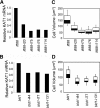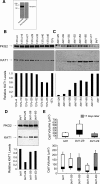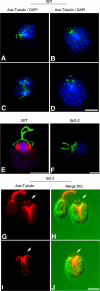Katanin knockdown supports a role for microtubule severing in release of basal bodies before mitosis in Chlamydomonas
- PMID: 19005222
- PMCID: PMC2613114
- DOI: 10.1091/mbc.e07-10-1007
Katanin knockdown supports a role for microtubule severing in release of basal bodies before mitosis in Chlamydomonas
Abstract
Katanin is a microtubule-severing protein that participates in the regulation of cell cycle progression and in ciliary disassembly, but its precise role is not known for either activity. Our data suggest that in Chlamydomonas, katanin severs doublet microtubules at the proximal end of the flagellar transition zone, allowing disengagement of the basal body from the flagellum before mitosis. Using an RNA interference approach we have discovered that severe knockdown of the p60 subunit of katanin, KAT1, is achieved only in cells that also carry secondary mutations that disrupt ciliogenesis. Importantly, we observed that cells in the process of cell cycle-induced flagellar resorption sever the flagella from the basal bodies before resorption is complete, and we find that this process is defective in KAT1 knockdown cells.
Figures






References
-
- Bradley B. A., Quarmby L. M. A NIMA-related kinase, Cnk2p, regulates both flagellar length and cell size in Chlamydomonas. J. Cell Sci. 2005;118:3317–3326. - PubMed
-
- Brazelton W. J., Amundsen C. D., Silflow C. D., Lefebvre P. A. The bld1 mutation identifies the Chlamydomonas osm-6 homolog as a gene required for flagellar assembly. Curr. Biol. 2001;11:1591–1594. - PubMed
-
- Brodersen P., Sakvarelidze-Achard L., Bruun-Rasmussen M., Dunoyer P., Yamamoto Y. Y., Sieburth L., Voinnet O. Widespread translational inhibition by plant miRNAs and siRNAs. Science. 2008;320:1185–1190. - PubMed
-
- Buster D., McNally K., McNally F. J. Katanin inhibition prevents the redistribution of gamma-tubulin at mitosis. J. Cell Sci. 2002;115:1083–1092. - PubMed
-
- Cavalier-Smith T. Basal body and flagellar development during the vegetative cell cycle and the sexual cycle of Chlamydomonas reinhardii. J. Cell Sci. 1974;16:529–556. - PubMed
Publication types
MeSH terms
Substances
Grants and funding
LinkOut - more resources
Full Text Sources
Other Literature Sources

